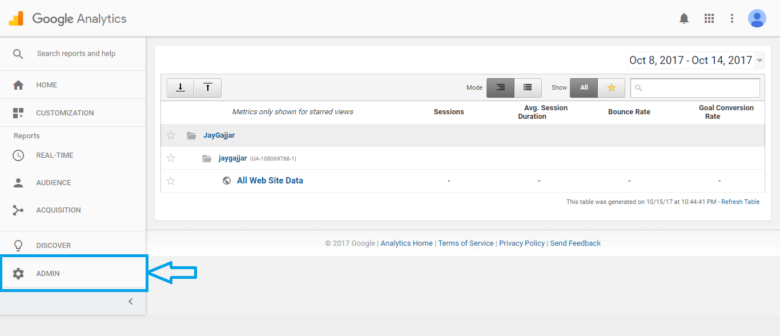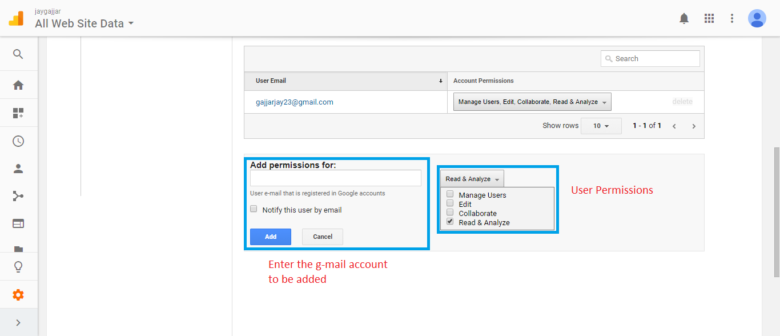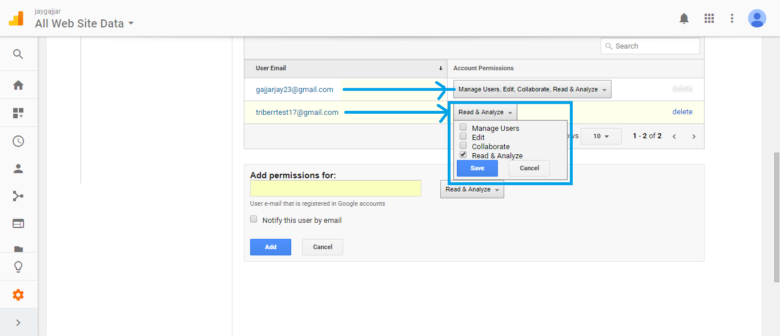Google Analytics allows you to grant access to other users so you can share traffic data or allow them to manage the account.
User Account Levels
Users / Clients can be added at an account, property, or view level. The level at which a user is added determines that user’s access.
- Account – At the account level, the access to ALL the properties and views in that account will be granted to the user.
- Property – At the property level, that user has access ONLY to that property and no other level.
- View – At the view level, the user has access to ONLY that view with the permissions you provide.
User permissions can be changed at any time. Note that users are identified by their email address, and can only be granted access to their Google-specific email address (a Gmail account or a Google Suite email address).
User Permissions
Team members can be added to the Google Analytics account of the owner as users with four distinct levels of user access. These user permissions can be allocated either individually or in combination. They are as follows:
- Manage Users: Allows management of account level users (add/delete users, assign permissions). However, Edit and Collaborate are mot included.
- To add or modify users, one must have Manage Users access at the account, property, or view level. Users can be added or modified at each level with varying permissions.
- To delete users, one must have Manage Users access at the account level. Account level is the only level where users can be deleted. As a safety precaution, The last user who with Manage Users access, cannot delete themselves.
- Edit: Allows directorial and report-related functions (connect/modify/remove accounts, properties, views, filters, etc., but not manage users), and see report data.
- Assign Permissions
- Prerequisites: At account level, required to create filters. At view level, required to apply filters.
- Inclusive of Collaborate.
- Collaborate: Allows the user to create, share and collaborate on shared assets. Examples of assets are dashboards and annotations. Inclusive of Read and Analyze.
- Create and share individual or personal assets
- Modify / Update a dashboard or shared segment or annotation
- Segments: Google Analytics users with Collaborate level permissions can allocate a Custom Segment which is shared via the Create Segment panel and also from Share Assets located in the Admin panel for the defined View. Also known as Segment Availability. It is present towards the top right of the screen when you are creating or updating / editing a Custom Segment.
- Dashboards:are small reports / widgets that can show your information in different introduction styles, including straightforward numeric tables and outlines.. You can define widgets within the Dashboard itself. Widgets can also provide snapshots of and link to standard or custom reports.
- Annotations: are short notes (<= 160 characters) around the interface. They are similar to sticky notes / comments or reminders on your report. After the data procession is complete, these notes can be attached to the reports which would help spot correlation with data from other reports or some external data.
- Read and Analyze: Allows the user to:
- See reports and configuration data.
- Modify /Update data within reports (e.g. create segments, tables can be filtered).
- Create individual assets, and share them and also view shared assets.
- Does NOT permit the user to collaborate on shared assets.
Important Notes:
- Hierarchy of permissions (by level): Account > Property > View.
- Parent permissions are inherited by default by the children. For instance a user at account level will automatically have access for the property level and view level. A user at property level will have the access for view level but NOT for account level.
- Access for a child supersedes that defined for the parent.
- Down the hierarchy, more access / permissions can be assigned but not fewer. For instance, if at the account level has Collaborate permission, then at lower (property and view) levels, Edit permission can be allocated to them but they cannot be limited to Read and Analyze.
- Your Agency/ Company should be granted the Manage Users or Edit role so that they can effectively manage your Google Analytics account and make changes as per the necessity. Only a certain amount of individuals / clients need edit access. For example, individuals in your company who are well versed with Google Analytics. Only the owners or the Agency members hired to help setup or implement Google Analytics should have this access.
- Editors and Authors can be given Collaborate permission based on the level of privacy comfortable to the Owner/ Agency/ Company. The users to be granted collaborate access to would be those who are not well versed with Google Analytics, but they may work closely with individuals from different divisions who advantage from seeing certain information from Google Analytics. These clients can go into Google Analytics and make the custom segments or dashboards they have to present to different offices without coincidentally ruining any information.
- The Read and Analyze access should be given to those who only need to view data in Google Analytics, check how the present advertising effort is doing or the number of registrations or donations you have received for the new conference you are going to host. Third parties or individuals who you want to share the data with but for who, you also want to restrict the ability to make any changes. For instance, you may have a content writer who requests Google Analytics permission / access to understand which articles are performing better than others. Therefore, give them read & analyze access as they do not require the ability to edit settings.
Add users
There is no restriction of the number of users that can be added. To add a new user:
1. Log in to Google Analytics.
2. Go to Admin, and choose the desired account / property / view level.
3. In the ACCOUNT, PROPERTY, or VIEW column (conditional upon which level you need to change authorizations at), go to User Management.
4. Enter the Gmail address of the user under Add permissions for: as shown in the screenshot below.
5. Choose the permissions / level of access you want to allocate to the user.
6. We recommend you check the “Notify this user by email” checkbox so that the user is aware of the granted permissions.
7. Click on Add.
Modify users
The permissions for any user at any particular level can be modified in an Analytics account. For example, a user with Read permission for only one view, can subsequently also be given the Edit level access for only that view. Or one can give that user Edit access at the property level, and thereby also give Edit access for every view in that property.
To modify access for an existing user:
1. Log in to Google Analytics.
2. Go to Admin, and choose the desired account / property / view level.
3. In the ACCOUNT, PROPERTY, or VIEW column (conditional upon which level you need to change authorizations at), click User Management.
4. In case of a long user list, use the search box located at the top to find the user you need. ( e.g., myteam@gmail.com or myteam).
5. Use the selector in the Account Permissions column to update / modify (add or remove) permissions for the user.
6. Click Save.
Delete users
Although users can be added at any level in the account hierarchy, users can be deleted only at the account level.
To delete a user:
- Log in to Google Analytics.
- Go to Admin, and choose the desired account.
- Select User Management in the Account column. Delete option is not visible for User Management under PROPERTY or VIEW levels.
- In case of a long user list, use the search box located at the top to find the user you need. ( e.g., myteam@gmail.com or myteam).
- Click Delete for the user you want to delete.
Note: delete is present at the right for each indvidual user row. If delete is not visible, you are in User Management at the property or view level. To delete a user, you must be in User Management at the account level. - Click Delete user.
Please post your questions regarding sharing Google Analytics with your team mates in the comments below.












2 Responses
Great article. Very helpful
Nicely explained.